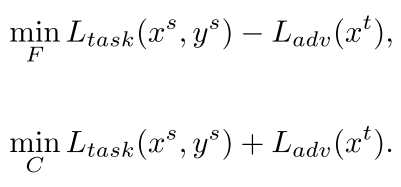Kim, S., Choi, J., Kim, T., & Kim, C. (2019). Self-training and adversarial background regularization for unsupervised domain adaptive one-stage object detection. In Proceedings of the IEEE International Conference on Computer Vision (pp. 6092-6101).
Introduction
The paper introduce a weak self-training (WST) method and adversarial background score regularization (BSR) for domain adaptive one-stage object detection.
Approach
Problem Setting:
We assume that source data is drawn from the source domain , and target data is drawn from the target domain . Here, x is an image and  is a corresponding label, where  is the coordinates of the bounding box and  is the class to which the object belongs. We denote the distribution of domain  as , and . <br />False Positive(假正,**FP**):将负类预测为正类数<br /> False Negative(假负,**FN**):将正类预测为负类数
Weak Self-Training(WST):
Reducing False Negatives: 
论文中采用SSD作为基本检测器,如上图原loss分为三部分,和
分别指的是目标多分类和背景的二分类loss,
指的是localization loss,在SSD中即是offset
.
Negative examples in the set have a large potential of being foregrounds,Thus, the proposed method choose
examples that have the lowest confidence loss value among negative examples in
. the method do not update the network for bounding box regression since pseudo-labels usually have inaccurate bound- ing box information. The modified loss function:

Reducing False Positives: supporting RoIs denote examples having IoU value larger than some threshold with the final detection
. SRRS (Supporting Region-based Reliable Score):

首先提出的论文采用SSD,输出是,
is the
detection and
is the total number of detections (e.g., n = 8732 for SSD300), 在NMS之后的输出为
, 论文中选用这个作为pseduo的候选框。在这里,简单来说就是提出了一个SRRS来评分每一个产生的positive pseduo label,而不是简单使用a single confidence score, 作者认为all the boxes 都趋向于最终的检测结果
, 对于每一个
计算每个
和这个框的
,再取平均值,如上述公式,最终得到一个score(SRRS),然后与一个阈值比较得到最后的pseduo label。
Adversarial Background Score Regularization(对抗背景评分机制):
backgrounds of the source domain and target domain share less common features compared to those of foregrounds. Motivated by [3], the paper propose background score regularization (BSR) in an adversarial way. BSR extracts discriminative features for target backgrounds.
上面是一个二分类交叉熵,当我们minimize the loss的时候,the value of 趋向于t。反之当我们maximize the loss的时候,
趋向于0或者1.
具体的BSR背景对抗规则如下:
对于source输入,都进行minimize强监督优化学习。对于target inputs,优化C(classifier)的输出接近t,通过minimize
loss。相反,优化 F(Feature extraction)的输出
趋向于0或者1. 从而最终造成F的error增大,去欺骗C进行unkown class的判别。进而学习得到discriminative feature。
最终的一个背景对抗评分loss如下图所示:
在这里. 具体实施在这里,the paper enable the adversarial training using gradient reversal layer (GRL) right after relu4 3 of SSD300. Figure 4 depicts the process of the adversarial learning.
 **
**


